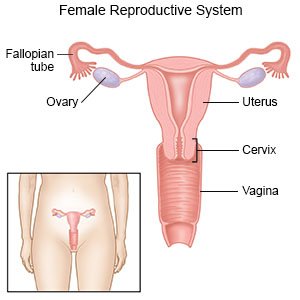Hysteroscopic Sterilization
Medically reviewed by Drugs.com. Last updated on Apr 6, 2025.
Hysteroscopic sterilization is a procedure to block your fallopian tubes to prevent pregnancy. Small coils made of nickel or titanium are guided into your fallopian tubes. Scar tissue builds up around the coils. The scar tissue prevents sperm from reaching an egg. The coils will never be removed from your fallopian tubes. This is a permanent form of birth control. You will need to be sure you will not ever want to become pregnant before you have this procedure.
 |
DISCHARGE INSTRUCTIONS:
Seek care immediately if:
- Your legs are swollen, warm, and painful.
- You have very bad stomach or pelvic pain.
- You have large amounts of vaginal bleeding and it is not time for your monthly period.
Contact your healthcare provider or gynecologist if:
- You feel dizzy or you have fainted.
- You think or know that you have become pregnant.
- You have a fever.
- You have pain in your lower back, legs, hips, or thighs.
- You have foul-smelling vaginal discharge.
- You have nausea and are vomiting.
- You have questions about your condition or care.
Medicines:
- Acetaminophen decreases pain and fever. It is available without a doctor's order. Ask how much to take and how often to take it. Follow directions. Read the labels of all other medicines you are using to see if they also contain acetaminophen, or ask your doctor or pharmacist. Acetaminophen can cause liver damage if not taken correctly.
- NSAIDs help decrease swelling and pain or fever. This medicine is available with or without a doctor's order. NSAIDs can cause stomach bleeding or kidney problems in certain people. If you take blood thinner medicine, always ask your healthcare provider if NSAIDs are safe for you. Always read the medicine label and follow directions.
- Take your medicine as directed. Contact your healthcare provider if you think your medicine is not helping or if you have side effects. Tell your provider if you are allergic to any medicine. Keep a list of the medicines, vitamins, and herbs you take. Include the amounts, and when and why you take them. Bring the list or the pill bottles to follow-up visits. Carry your medicine list with you in case of an emergency.
Activity:
You may be able to return to your daily activities on the day of your procedure. Ask when you can return to work, exercise, or other activities.
Birth control:
It will take at least 3 months for your tubes to be completely blocked. You will need to use a form of birth control during this time to prevent pregnancy. Talk to your healthcare provider or gynecologist about what kind of birth control is best for you.
Prevent blood clots:
Deep vein thrombosis (DVT) is a condition that causes blood clots to form inside your veins. You may be at an increased risk for DVT after your procedure. Ask your healthcare provider or gynecologist for more information about how to prevent DVT.
Follow up with your healthcare provider or gynecologist as directed:
You will need to see your healthcare provider or gynecologist a few months after your procedure. You may need a hysterosalpingogram, ultrasound, or pelvic x-ray. These tests are done to check your tubes and make sure they are completely blocked. Your healthcare provider may also check if the coil inside each tube is in the right place. Ask for more information about these tests. Write down your questions so you remember to ask them during your visits.
© Copyright Merative 2025 Information is for End User's use only and may not be sold, redistributed or otherwise used for commercial purposes.
The above information is an educational aid only. It is not intended as medical advice for individual conditions or treatments. Talk to your doctor, nurse or pharmacist before following any medical regimen to see if it is safe and effective for you.
Further information
Always consult your healthcare provider to ensure the information displayed on this page applies to your personal circumstances.
